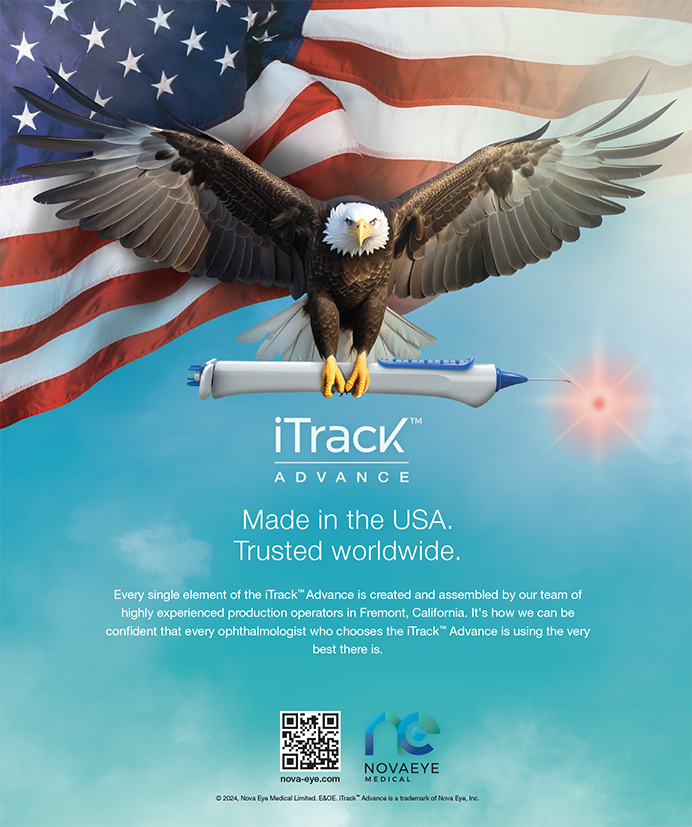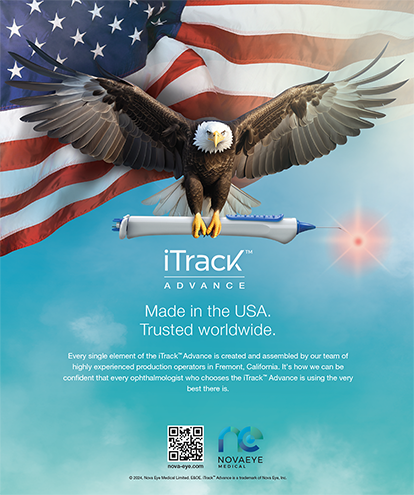A cornerstone of successful laser vision correction is the accurate centration of the ablation zone over the entrance pupil. Symptoms of poor visual acuity, poor quality of vision, loss of contrast sensitivity, halos/glare/starbursts, and multiple images (monocular polyopia) have all been reported after both PRK and LASIK in which a significant decentration has been observed.1 In general, the widespread adoption of eye-tracking systems for routine use during laser procedures as well as greatly expanded ablation zone diameters effectively eliminated cases of decentration. Small, subclinical decentrations still occur, however, typically with minor and easily managed symptoms and side effects (Figure 1).
For the purpose of this review, decentrations will be broadly divided into three categories: large (> 1 mm), moderate (0.5-1 mm), and small subclinical (< 0.5 mm). The decentration of an ablation zone is defined as the difference between pre and postoperative corneal topography measurements using tangential maps, as described by Mrochen, Kaemmer, and others.2 Using this method, the area of the intended laser ablation surrounded by a region of approximately zero power is calculated, and the eccentricity is then determined by the distance between the center of the flattened zone and the center of the entrance pupil. Other methods to characterize the extent of decentration include the center of flattest power,3,4 a vector center-of-mass formula,5 and Fourier analysis of corneal power components.6
LARGE DECENTRATIONS
Although uncommon today, large decentrations can be the most challenging to manage. Seiler and McDonnell presented the first case of diametral ablation to compensate for a grossly decentered ablation in 1995. Noting even then that decentrations of less than 1 mm are usually well tolerated by patients, the authors described a laser profile delivered at an opposite but equal distance 180o from the topographic location of the primary correction.7 Pallikaris later proposed a theoretically similar approach not using a laser. He performed an arcuate keratotomy across the axis of decentration, also 180° from the center of the primary ablation.8 Both techniques had the same goal: the normalization of corneal topography in an effort to reduce visual symptoms and improve the patient’s BCVA.
Currently, there are two schools of thought regarding how to treat large decentrations with a laser. Each has advantages and disadvantages. The wavefront-guided approach can simultaneously normalize the corneal topography and address the patient’s residual refractive error. The primary limitation of this method is that large decentrations tend to be associated with high amounts of induced higher-order aberrations. As a result, it is difficult or even impossible to capture the necessary data to formulate a treatment plan.
The second option is a topography-guided approach, which builds on the Visx Custom-CAP (contoured ablation pattern; Abbott Medical Optics Inc., Santa Ana, CA) that was approved in the United States in 2001 under a Humanitarian Device Exemption9—a method no longer used. In my experience, Visx Custom-CAP was effective, but it lacked simplicity and invariably was a planned two- stepped procedure. Despite tremendous progress abroad in the restoration of the cornea’s topographic asphericity with topography-guided methods, none of these methods is approved in the United States. Perhaps the most compelling work has been that of Arthur Cummings, FRCSEd, who has reported success with both the Allegro Oculyzer and Topolyzer (Wavelight AG, Erlangen, Germany).10 A two-stepped procedure, with one portion performed by necessity outside the United States, however, is generally not appealing to US patients and presents obvious logistical hurdles.
Perhaps the best solution combines these approaches by using topographic data and wavefront technology. Dan Reinstein, MD, reported satisfactory refractive outcomes after one treatment of the decentration with the MEL 80 CRS-Master TOSCA II software11 (Carl Zeiss Meditec AG, Jena, Germany; not available in the United States). The forthcoming iDesign (Abbott Medical Optics Inc.) holds great promise as well. With a higher resolution aberrometer for better capture rates on highly aberrated eyes and a topographic overlay to assist the pulsing of the wavefront-guided ablation, the iDesign will likely represent a significant step forward in the combination of topographic and wavefront data to treat eyes with clinically significant decentrations.
MODERATE DECENTRATIONS
The clinical approach to moderate decentrations is generally dictated by whether or not wavefront capture is possible. Usually, but not always, visual symptoms associated with decentrations of this magnitude are alleviated with a single wavefront-guided retreatment that normalizes the topography and adequately addresses the refractive error.
SMALL DECENTRATIONS
Usually,decentrationsaresmallandsubclinical.Studies on tracker-assisted LASIK for myopia have reported mean decentrations of between 0.35 and 0.55 mm, and research on PRK for myopia has reported similar mean decentrations of between 0.33 and 0.42 mm.12 In the absence of a refractive error, these decentrations generally are not associated with visual symptoms.
Assuming that the fixation target is coaxial with the surgeon’s view, which is normally the case, small, subclinical decentrations are likely due, at least in part, to a somewhat eccentric location of the first Purkinje image in relation to the center of the pupil. This distance can be greater than 1 mm in hyperopic and highly myopic eyes, but it is less than 0.5 mm in most eyes.2 The amount of decentration can be significantly greater with a higher attempted correction or with a small optical zone ablation.
CONCLUSION
A patient’s ability to tolerate a decentration of any magnitude can be surprising. Fortunately, the problem has been greatly reduced by the advent of laser profiles that commonly use 6-mm optical zones and ablation zones that extend to 8 mm or beyond. Also of benefit is a general trend toward offering high myopes surgical alternatives such as lens-based procedures.
Innovative efforts to treat large decentrations before eye trackers became available significantly increased the accuracy of even routine laser vision correction on nor- mal eyes. Continuing research will likely result in laser platforms that routinely integrate topographic data with wavefront data to deliver ablations of excellent quality and exceptional precision.
Stephen Coleman, MD, is the director of Coleman Vision in Albuquerque, New Mexico. He acknowledged no financial interest in the products or companies mentioned herein. Dr. Coleman may be reached at (505) 821- 8880; stephen@colemanvision.com.
- MrochenM,KruegerRR,BueelerM,SeilerT.Aberration-sensingandwavefront-guidedlaserinsituker- atomileusis: management of decentered ablation. J Refract Surg. 2002;18:418-429.
- MrochenM,KaemmererM,MierdelP,SeilerT.Increasedhigher-orderopticalaberrationsafterlaserrefractive surgery:aproblemofsubclinicaldecentration.JCataractRefractSurg.2001;27:362-369.
- Cavanaugh TB, Durrie DS, Riedel SM, et al.Topographic analysis of the centration of excimer laser photorefrac- tive keratectomy. J Cataract Refract Surg. 1993;19(suppl):136-143.
- Schwartz-Goldstein BH,Hersh PS.Corneal topography of phase III excimer laser photorefractive keratectomy. Optical zone centration analysis. Summit Photorefractive Keratectomy Study Group. Ophthalmology. 1995;102:951-962.
- Almendral D,Waller SG,Talamo JH.Assessment of ablation zone centration after photorefractive keratectomy using a vector center of mass formula. J Refract Surg. 1996;12:483-491.
- HjortdalJO,ErdmannL,BekT.Fourieranalysisofvideo-keratographicdata.Atoolforseparationofspherical, regular astigmatic and irregular astigmatic corneal power components. Ophthalmic Physiol Opt. 1995;15:171-185.
- SeilerT,McDonnellP.Excimerlaserphotorefractivekeratectomy.SurvOphthalmol.1995;40:89-118.
- PallikarisI,SiganosD.LASIKcomplicationsmanagement.In:TalamoJ,KruegerR,eds.TheExcimerManual. Boston, MA: Little, Brown;1997:227-244.
- Treating Decentered Ablations Using the Custom-CAP Method and the Zeiss Humphrey Systems VisionPro Ablation Planner.Santa Clara,CA:Visx,Inc.;2001.
- Cummings AB, Mascharka N. Outcomes after topography- based LASIK and LASEK with the Wavelight Oculyzer and Topolyzer platforms. J Refract Surg. 2010;26(7):478-485.
- Reinstein DZ, Archer TJ, Gobbe M. Combined corneal topography and corneal wavefront data in the treatment of corneal irregularity and refractive error in LASIK or PRK using the Carl Zeiss Meditec MEL 80 and CRS-Master.J Refract Surg. 2009;25:503-515.
- Giaconi JA, Manche EE. Ablation centration in laser in situ keratomileusis for hyperopia: comparison of VISX S3 ActiveTrak and VISX S2. J Refract Surg. 2003;19:629-635.


